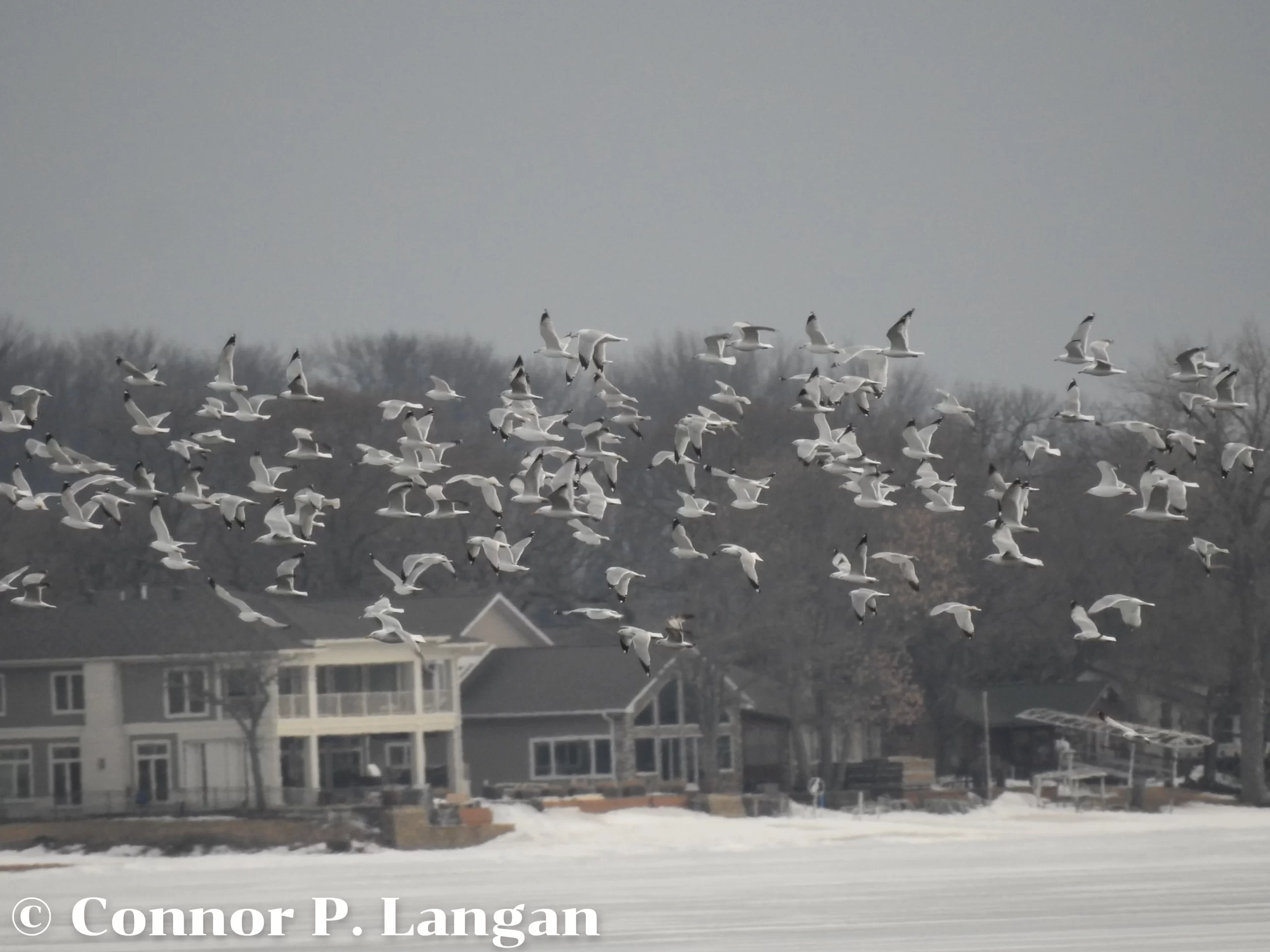Seagulls, also known as “gulls”, are one of the world’s most widespread and abundant groups of birds. They can seemingly be observed no matter where one travels, and they are widely protected throughout their range. However, gulls are noticeably absent during certain times of the year. Therefore, do seagulls migrate? If so, why do gulls migrate?
Yes, most species of seagulls migrate, with some birds traveling more than one thousand miles as they navigate to and from their breeding grounds. Birds will remain on the breeding grounds for several months before heading to a hospitable winter home.
Table of Contents
Hey! If you’d rather learn about seagull migration in the form of a video, you’re in luck! I created a YouTube video about this topic that you can view here:
When Do Seagulls Migrate?
The migration of most birds coincides with the changing of seasons, but when do seagulls migrate? More specifically, what month do seagulls migrate?
Well, most gulls begin to migrate as the snow melts in the north and starts to open up frozen bodies of water. Therefore, watch for the first to show up in early spring. These birds will continue to migrate through an area for the next few months.

How about in autumn – do seagulls fly south for the winter? Well, gulls are like many other birds in that they will begin moving south following the breeding season. They will show up in considerable numbers in many areas in October, and the fall migration will continue through much of December. As northerly locales begin to freeze, gulls will continue to migrate south until they find a large body of water that will not freeze in the winter.
Got it? Great, but do seagulls fly south for the winter across all species, or do some stay put throughout the year? I will discuss migratory seagulls and resident seagulls later in the article. For now, know that both types of gulls exist.
How Long Does Seagull Migration Take?
It seems like seagull migration is a lengthy process, so what month do seagulls migrate to start and when does migration end? Well, the amount of time that gulls spend migrating will vary by species, as the ancestral breeding grounds of some may be much further north than those of other species.
Seagull migration is not typically a rushed affair, as some birds remain in an area for weeks. You may wonder, “Why do gulls migrate at such a slow pace?”. Indeed, gulls take their time on migration compared to songbird species. Seagulls can be afforded the luxury of a slow migration because they are not as susceptible to cold temperatures as smaller birds such as swallows and blackbirds would be. This allows them to take their time and fatten up on food to fuel their journey.
Some gulls may commit four to five months out of their year to migrating to and from their breeding grounds, while others may only need to commit a month to their migratory journey.
Why Do Seagulls Migrate?
Alright, so we know that gulls migrate, but why do seagulls migrate? This seems like an awful lot of work for these birds to put themselves through, so why are seagulls migratory birds?
Well, gulls migrate to take advantage of the seasonal abundance of food and habitat that may not exist at other times of the year.
In the summer, millions breed on the arctic tundra since this area is rich in food and nesting habitat. Most gulls depart from this area after the breeding season, as the tundra freezes up and becomes inhospitable for most species in winter.

Gulls typically travel to warmer locales during the winter months, as such locations offer plenty of food to accommodate a seagull diet.
So, why don’t gulls simply stay in one place throughout the year? Well, some species do! Species such as the Laughing Gull remain in the same areas along the Atlantic coast for the whole year, while species such as Herring Gulls and Ring-billed Gulls tend to move around seasonally.
Other birds head north to take advantage of the ample opportunities for food and nesting habitat that can be found during the summer. Indeed, during this prosperous time, it is often easy for seagulls to dive and capture fish.
Do Seagulls Migrate In Flocks?
Gulls tend to be social birds, as they often breed in large colonies with others. Moreover, they associate with groups of other gulls during the nonbreeding season. Being so social allows them to relay information to one another about food sources or warn of potential danger. Considering this information, do seagulls migrate in flocks?
It should be no surprise that seagulls commonly migrate in flocks. Migratory gulls such as Franklin’s, Bonaparte’s, and Black-headed Gulls frequently migrate together.
However, not all gulls are known to migrate in flocks. Even the species with a reputation for migrating in flocks are commonly found traveling by themselves.
Gulls do not tend to migrate in mixed-species flocks on their seagull migration, instead migrating with others of the same species.
It seems that gulls are content with either migrating individually or in the company of others. If the conditions are good for migration and a gull finds themselves in the presence of other gulls, they may all migrate together.
However, gulls are equally content to set out on their own to get themselves where they need to go.
Do Seagulls Migrate During The Day Or Night?
Where do seagulls go at night? You may assume that seagulls aren’t active during the night since these creatures are seemingly diurnal, but do seagulls fly at night?

Although you’ve surely noticed seagulls flying during the day, this does not necessarily mean that these creatures don’t have night lives. It turns out that sleeping is not the only thing that gulls do at night, as seagulls may migrate during either day or night. It seems that these birds can find their way in light or darkness.
This may seem surprising to some, but this behavior is commonplace in birds. From hummingbirds to ducks, many birds migrate at night.
You may notice a gull flying around during the day. This bird could be migrating, or it could be traveling to a site where it will spend most of the day feeding before returning to a body of water where it will roost for the night.
Where Do Seagulls Go In The Winter?
So, where do seagulls go in the winter if they migrate? Do seagulls fly south for the winter like geese? Well, gulls travel to large, open bodies of water in the winter months. Plenty of options exist for gulls looking for a place to spend the winter, but where do seagulls migrate to in winter, exactly?
Look for gulls in the following habitats during winter:
- Beaches
- Lakes and lakeshores
- Marshes
- Reservoirs
- Landfills
- City parks
Okay, we know that seagulls may migrate south for winter, but what do seagulls do in the winter? Well, during the winter, gulls may be found on beaches, reservoirs, lakes, and landfills. Landfills attract large numbers of gulls with the abundant amount of food that they offer to these birds.
In the summer, most gulls breed in colonies near water. Islands, beaches, remote lakeshores, and marshes are places where this species might breed.

Conclusion – Do Seagulls Migrate?
Do seagulls migrate? We now know that the answer to this question is yes, but why are seagulls migratory birds? Although some species of seagulls migrate, this does not mean that all gull species migrate. Some gulls are happy to stay in the same area for the whole year. However, for those species that do migrate, where do seagulls go in the winter?
Recall that seagulls that do migrate do so to take advantage of seasonally abundant sources of food and breeding habitat. During the winter, gulls head south and find an open body of water where they can find food throughout the winter.
Gulls may migrate during the day or night, so if you suddenly notice that all of the seagulls in your area are gone, you know where they’ve gone.
Here are some quick facts to wrap up the article:
- Are seagulls migratory birds? Yes
- When do seagulls migrate? Gulls typically migrate in spring and autumn
- Do seagulls fly south for the winter? Yes, some gulls do, while others remain in one place all year
- Where do seagulls go in the winter? Any place with unfrozen water can support seagulls in winter
- Do seagulls migrate in the winter? Gulls typically don’t migrate in the middle of winter, but they often move around quite a bit during the day

